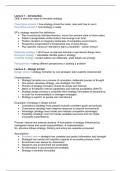Lecture 1 – Introduction
O&E is about ten ways to formulate strategy
Prescriptive schools = how strategy should be made, rules and how to use it
Descriptive schools = how strategy is made
5P’s: strategy requires five definitions:
Plan (consciously intended direction, move from present state to future state)
Pattern (recognizable similar actions that emerge over time)
Position (location in imaginary landscape of competitive environment)
Perspective (organization’s fundamental way of doing things)
Ploy (specific maneuver intended to fight a competitor – power school)
Deliberate strategy = strict focus on planned direction to get desired things done
Emergent strategy = adjustable, flexible goals in strategy
Umbrella strategy = broad outlines are deliberate, while details can emerge
Perspectivism = taking different perspectives in tackling a problem
Lecture 2 – Design school
Design school = strategy formation by one strategist, later explicitly implemented
Characteristics:
Strategy formation as a process of conception, deliberate process of thought
One person develops strategy, one strategist: the CEO
Process of strategy formation should be simple and informal
Match or fit between internal capabilities and external possibilities (SWOT)
Strategy design process is complete when strategy formulated as perspective,
no room for incrementalistic or emergent strategies
Strategy is explicit, so people can read about it
Evaluation of strategy in design school:
Consistency (strategy must present mutually consistent goals and policies)
Consonance (strategy have adaptive response to external environment)
Advantage (strategy must create and maintain competitive advantage)
Feasibility (strategy must not overtax available resources and not create
unsolvable subproblems)
Process: internal and external analysis formulation of strategy (influenced by
managerial values and social responsibilities) implementation
So: structure follows strategy: thinking and acting are separate processes!
Assumptions:
Economic man = strategist has complete and perfect information and foresight
Strategist has mental and cognitive capacity to accurately process al info
Environment can always be understood
Situations and environment are predictable
All information is documented and available
Strategy is centrally formulated
, Most applicable for large, old, established organizations (bc stable
environment) or young entrepreneurial, depends on timing
Criticism:
Capacity to learn is ignored (during strategy formation important to learn)
Structure follows strategy is unrealistic, not change whole structure of org
This school promotes inflexibility bc hierarchal, centralized, explicit strategy
Assumption of universality is wrong, there is not one best way for strategy
Detachment of thinking from acting, strategy forming is more a process
Strategist is unlikely to have all and perfect information, and capacity
Marketing myopia = only seeing yourself as just selling product, not satisfying need
Marketing hyperopia = worrying about future so much, not focused on selling now
Marketing macropia = overly broad view of your industry, trying too hard
Lecture 3 – Planning school
Planning school = strategy as a result of formal procedures, training, analysis
Characteristics:
Full-blown, detailed, and explicit strategies are formulated
CEO is responsible for overall formation process, staff planners for execution
> in reality: CEO only approves strategies, planners are major players
Clear focus on the future; scenario thinking; real options
Strategy formation is supported by checklists and analytical techniques, it is
way more complex with elaborated steps (while in design school it’s simple)
> machine assumption = produce everything according to book, that results
Rational and systematic approach to strategy making (influenced by
scientific management: no room for values or judgement)
Planning and implementation are separate, consecutive steps
There is interaction with the environment (while in DS navigate through env.)
Process: objective-setting internal and external analysis evaluation
operationalization and scheduling
Scenario planning = speculating on varieties of future, so that organization can
prepare itself, breaking the habit that future will look like present or past
Real options = managerial flexibility to adapt and revise future decisions, they are
used in uncertain and changing environments. It is based on financial options.
Strategic control = divisions are responsible for strategy, but must be approved and
monitored by headquarters
> parenting metaphor = headquarters are parents that control business (children),
parent advices and balances with control and discipline
Left-handed planners = encourage strategic creative thinking, emergent strategies
Right-handed planners = formal strategy analysis, clearly intended strategy
Assumptions:
Organizations are like machines
Organizations have a clear system of values, competencies, reward system
Environment is stable and predictable





